After an exciting Christmas break of travel and fun I find myself back in Eichstaett. I return with too many stories to tell, and no where near enough photos to share. I spent the first week of my all too short university break of two weeks with my family visiting from America. Their stay was a wonderful time, and I’m thankful they were able to visit me. I had a fun experience acting as their translator and guide for Germany. Hopefully they will be able to return for a second visit later in the year. The second week brought mostly solo travels to northern Germany and, due to my ever climbing curiosity to experience more on the European continent than German life, Amsterdam. With so much to tell, I believe it best to split up the two weeks into three posts: my family’s visit, northern Germany, and Amsterdam. Having said that, let’s go back to Christmas Eve, my family’s arrival date in Germany.
On that morning, I greeted my parents and my brother, Austin, bright and early in the Munich airport, with coffee cup firmly in hand after only three hours of sleep from the night before. In no time at all, somewhere around the lingerie store in Terminal Two, I began pointing out the differences of the German culture and America’s. We caught a train from the airport and arrived about three hours later to the wonderful town of Eichstaett. I brought my family to their beds for the next four nights, Hotel Fuchs, but from there we rushed back to the station to catch a train to Nuremberg, where we hoped to find the Christmas Market still open.
Arriving in Nuremberg around dusk, we walked to the market place only to find a lifeless square decorated with boarded up stalls. It was a skeleton of the spectacle that is the Nuremberg Christmas Market, which closed the day before my family’s arrival. We attempted to make the most of our Christmas Eve evening by walking around Nuremberg in search of a restaurant, but to no avail. We did find a vendor selling the traditional gluehwein, which I made sure my family tasted. Below you can see me and my brother toasting the holidays with the warm and bitter drink.

All other restaurants around town were closed due to Germany’s treatment of Christmas Eve as the main day of the Christmas holidays. We eventually gave up and returned to the train station for a Christmas Eve dinner of fast food. After the train ride to Eichstaett we tucked ourselves in for the night, probably a little more hungry than usual.
Christmas morning brought us to our feet early, or perhaps it was the promise of the hotel’s breakfast starting at 7:30. The meal was a typical German breakfast of cold cuts, cheeses, bread rolls, and cereals.
Then I conducted a tour of the university’s campus, which was next door to the hotel.
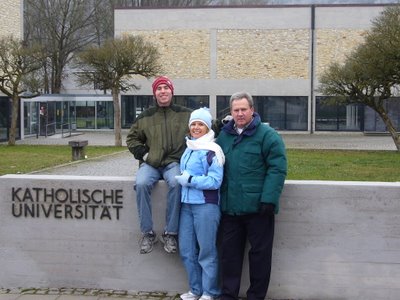
Next we walked to the cathedral in order to attend Christmas mass. The interior of the church was beautifully decorated for the holiday. I took this photo after the services, once most of the other people had left.

We hung around the cathedral for a little time as I showed my family around the different passageways of the old church. We returned to the hotel, gathered Christmas presents that my family had brought from home, and walked to my apartment to celebrate the day.
I had a few decorations up, Christmas simply isn’t Christmas for me without a evergreen tree.
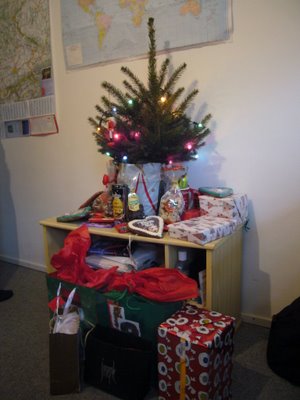
One of my gifts to the family was a large supply of German chocolates and sweets, which we munched on for the whole week.
After presents I showed them around all the corners and back allies of Eichstatt. We ended the day with an excellent German meal at one of my favorite restaurants in town, Trompete. My dad finally enjoyed the bratwurst for which he spent so much time longing. By his seemingly insatiable craving for the spicy sausages a German might surmise that such food items are nonexistent in America. Although I have an idea of where he’s coming from; I will probably enjoying a heaping portion of Memphis barbeque when I return home. We then returned to the hotel and laid down to bed in a more satisfied condition than the night before.
At the start of the new day, after another delicious breakfast of deli meat and cheese, we hiked up the eastern valley ridge to search for some of the famous Eichstaett fossils.
Upon reaching the top of the ridge we discovered a confectionary landscape of trees and plants glazed with a think coating of frost.
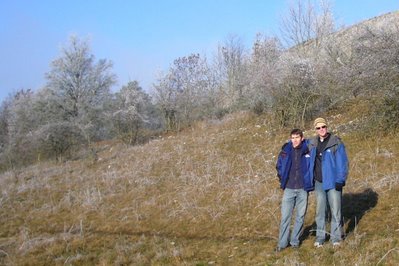
We trekked to the summit of the quarry deposits for a bird’s eye view of Eichstaett. The limestone mining companies around Eichstaett leave behind towering mounds of rocks in which they find little value, but with a careful eye one can easily find handfuls of fossils in the waste. Such fossils can actually fetch a meager price down in the gift shops of Eichstaett, but for those willing to hike to the mounds all specimens come free of charge. Here’s a view of one of the limestone quarries and the mounds.

After finding a collection large enough to open a small museum of simple plant fossils, we crossed over to the other side of the valley to Willibaldsburg, the castle over Eichstaett, in order to tour the natural history museum found inside the fortress’ chambers. The best preserved fossil of an archaeopteryx, the earliest bird known to exist, is found in the museum’s collection.

Finished with the museum, we boarded a train to Rothenburg ob der Tauber. Unfortunately, all of the shops were closed in the beautiful medieval town because it was the day after Christmas. We wandered the streets for a couple hours before returning to Eichstaett for dinner. Actually the high point of the trip was the story of Austin’s gloves, which he had left behind on the train leaving from Eichstaett, and found again on the same train returning to Eichstaett. A wonderful example of the honesty of the German people.
We awoke Wednesday to breakfast and a midmorning train ride back to Nuremberg. Our first stop in the city was the Nazi Documentation Center and the historically preserved site the Nazi Festival Grounds. The Center is housed in what was to be the Nazi Congress Hall for political conventions and meetings. The museum here presents an exhibit which explains the purpose of the Festival Grounds, how Hitler was able to come to power, and the war crime tribunals which were held in Nuremberg and put many of the defeated Nazi higher-ups on trial. Below is a photo of the grandstand found at the Zepplin Field, a site of parades and speech-giving at the Festival Grounds. Hitler spoke here during the annual Nazi festival. You have probably seen the photographs or film clips of him standing high on the center platform, overlooking a sea of mesmerized faces. Notice the sign on the left that reads, “Enter at your own risk.”

We left the Festival Grounds and took in the Germanisches Nationalmuseum, reportedly the best museum on German culture. The knight and medieval weapons exhibit won the prize as my favorite exhibit.

Also on display was the world’s oldest known globe, which is the only globe left that does not depict North and South America. The globe’s maker produced it only a few years before Columbus reached the West Indies in 1492.
We ate dinner in Nuremberg and returned to Eichstatt to pack our bags, for on Thursday morning we were to leave for Munich, where we spent the last two full days of my family’s stay.
In order to satisfy my parents’ desire for souvenir shopping, we remained in Eichstatt until around noon. We arrived in at our hotel in Munich only to check-in and leave for the Dachau Concentration Camp Memorial in the hinterland of the city.
I visited Dachau two and half years ago during my whirlwind two week tour through Germany, but the memorial impacted me as strongly as my first visit. Dachau was the first concentration camp constructed and acted as the trendsetter for all of the following ones. Rather than a holding ground for primarily Jewish prisoners like other concentration camps, Dachau imprisoned a more diverse group of individuals dangerous to the Nazi’s government control and other “undesirables.” Below, ones sees the eerily desolate field before the administration building of the camp. Prisoners would line-up in the field each morning for the daily roll-call.

Here is a photo of the perimeter fence around the camp. The grass between the fence and the gravel was the forbidden zone. Any prisoner walking here would be shot on site by guards in the tower.
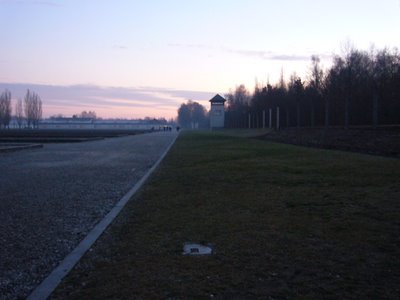
One also has the opportunity to view the camp gas chamber and crematorium. The gas chamber was never used for mass killings of prisoners, nonetheless the Nazi soldiers murdered many souls within the chamber’s walls. The crematorium was built as a response to the ever increasing number of corpses and decreasing room for burial on the camp grounds. One sign in the room described how the camp soldiers would bring prisoners into the crematorium, hang them on the wooden beams over the crematories, then place the bodies, two at time, into the fires. When American forces liberated the camp and discovered these atrocities, including a room stacked high with corpses destined for cremation, they forced all the residents of the nearby town of Dachau to view it for themselves. Most of the residents proclaimed they had no idea such heinous acts took place behind the camp’s barbed wire fence.
After this solemn experience we returned to the Munich and ate dinner at Augustines, the oldest restaurant in the city. It opened sometime in the 1300s and still serves classic dishes of Bavaria and Munich, such as weisswurst (white sausage), pork knuckle, and roasted duck .

Friday, the last full day of my family’s stay in Germany, started with a visit to the Deutsches Museum, the largest and oldest science and technology museum in the world. You see it pictured below on the left banks of the Isar River. Some of the highlights included the first German submarine (or U-Boot), early prototypes of Hitler’s V2 rockets (the forerunners to intercontinental ballistic missiles), and one of the Wright brother’s series of airplanes. I find it interesting, and amusing, that the museum exhibit mentions that a German actually invented a successful winged aircraft before the Wright brothers, who simply invented the first motor-powered aircraft.
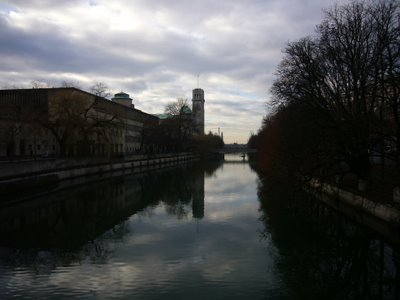
While the Deutsches Museum alone offered enough to keep us busy for the whole day, we left for a bout of ice-skating on an open air rink in the city center. It was my first time ever, but I’m happy to report that I only had one minor fall, more of a stumble really. It was mom’s first time since the seventh grade, so she too was a little less than graceful on the ice. However, my brother had the most experience out of the three of us and didn’t hesitate to show it. My dad, who desired to remain in strong frictional contact with the ground beneath him, took the photo below of us pausing on the side of the rink.

Then the family split up in order to accomplish our own agendas. My parents stayed together to spend some more time shopping around the center city, while my brother and I caught the subway to the grounds of the 1972 Olympic Games.

In the photograph above one sees the Olympic Tower on the left, and on the right the metal canvass over the main stadium and other venues. Like a sleek metallic version of the Alps one can see on the horizon from Munich, the canvass dips and rises in graceful curves and angles, catching the sunlight and beautifully reflecting it back along the way. This canvass is, in my opinion, one of the finest examples of modern architecture in the world. The setting sun on the horizon offered a splendid pallet of blues, oranges, yellows, and reds amplified by the twisting metal, which at times appeared to radiate this spectrum itself.

My brother and I entered the main stadium, which until this past summer was the home field for FC Bayern-München, the popular Munich soccer team.

After the stadium we rode the elevator to the top of the Olympic Tower for a twilight view of Munich beneath us. In the following photograph one sees the silhouette of the Alps on the left side of the horizon.
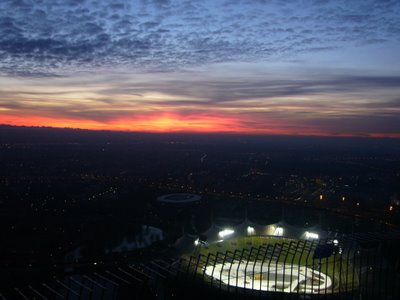
Walking back to the subway station we passed the headquarters for BMW, which is the highrise building pictured below. On the left side of the photo is the future BMW museum. It becomes fairly obvious how successful a company is, when it can open and operate a public museum dedicated to itself.

Family reunited, we dined at the famous Hofbraeuhaus restaurant and beer hall. A fitting way to end a week long tour through the towns and cities of Bavaria. We woke up early Saturday morning and left the hotel for the airport, where we said our final good-byes until either my return home, or a possible second trip my family could take later in the year.
With one great week behind me, I returned to Eichstaett to pack my bag and prepare for the next one. That night I caught a train to the North, where more adventures and experiences would find me in Hamburg, Luebeck, Bremen, and Hannover.



















1 comment:
Hey Nick, How fun seeing the pictures. It made the trip all current again in my mind. This is one of the top trips of my life. I am in love with Germany now and the whole lifestyle from the architecture, the religious relics and customs, the use of human energy. I say bring back bike riding to the market and train travel around the country.
I look forward to reading about the second week of your Christmas break.
Post a Comment